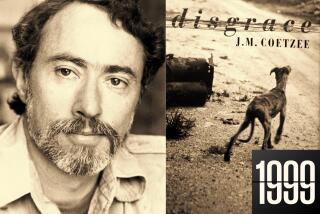Time to Move Past the Fault-Finding
Like evil twins locked in a nasty hair-pulling match, the battle between those who see Los Angeles as an Edenic paradise and those who see it as a polarized urban wasteland never loses its fury. This time the fight centers on “Ecology of Fear,” the recent book by culture critic Mike Davis, which presents Los Angeles as a city torn by civic strife and precariously balanced on the verge of environmental disaster.
The rage of Davis’ detractors stems from his refusal to look at the sunny side of things. An unrepentant socialist, Davis sees the city in terms of class conflict: urban ghettos plagued by crime pitted against fortified suburban sanctuaries. In a chapter wittily titled “The Case for Letting Malibu Burn,” for example, Davis argues convincingly that the resources used to prop up Malibu’s artificial ecology have drained much-needed services from a decrepit inner city. Infuriating his enemies further, his books resonate with the public--both “Ecology of Fear” and his earlier portrait of the dark side of L.A., “City of Quartz,” are bestsellers.
Clearly, Davis has struck a nerve. His adversaries have attacked him as a crackpot, a dark visionary of the apocalypse intent on destroying the city’s image. Led by Brady Westwater, a Malibu real estate agent, they have painstakingly combed through hundreds of footnotes and turned up some embarrassing inaccuracies, including Davis’ reference to the WASP enclave of Hancock Park as a Jewish neighborhood and his unsubstantiated claim that in one year 30 corpses were found in MacArthur Park. But increasingly, these same critics have resorted to vilifying Davis as a “city-hating socialist” and making pious references to his personal history.
Such self-righteous posturing evokes the culture wars underway in Washington. But the bickering also reveals a deep fissure in Los Angeles’ own cultural terrain. In the public imagination, the city has always been defined by two seemingly irreconcilable images: the City of the Apocalypse and the City of Sunshine. The former is the city of Raymond Chandler and the L.A. riots--seedy strips, cardboard houses and social violence--the latter, the city of civic boosters, endless beaches and dreamy, palm-lined driveways.
Like all myths, each of these has some basis in truth. Since the 1880s, when Southern Pacific Co. began promoting the region as a sunny land of splendor and affordable real estate, virtually every subsequent success story has been marred by a dark underside. The burst in population at the turn of the century led to the corruption and violent labor strikes that marked the mayoral campaign of 1911 (and included the bombing of the Los Angeles Times building). The flowering of the desert landscape can be attributed to the destruction of the Owens River Valley and the connected real estate boosterism (in which this newspaper also played a role). And the postwar housing boom led to the creation of the seedy, anonymous neighborhoods so darkly described in James Ellroy’s novels.
These opposing images so dominate perceptions of Los Angeles that they have crippled the broader dialogue about the city’s future--and the recent memories of the L.A. riots and the Northridge earthquake have only widened that rift. The result has been a climate marked by what social critic Christopher Lasch once referred to as “the cynicism that refuses to distinguish between ideas and propaganda, argumentation and ideological warfare.” Instead of a sustained public dialogue, we get partisan bickering. Instead of a lively civic culture, we get social isolation. This comes at a time when the city has an opportunity not only to nurture the isolated creative sparks that have always been part of L.A.’s odd cultural mix, but also to gently bind such free-floating enclaves into a civic whole for the first time in the city’s history.
It is a fissure that could have dismal consequences for the future. Los Angeles is entering another boom, this one cultural. It is building a new concert hall and cathedral, as well its first inner-city public rail system since closing down the last Pacific Electric Red Car line in 1961. It is about to embark on the construction of 50 new public schools at a cost of $1 billion. More than 50 government and private building projects are being proposed for downtown’s Civic Center, including a $293-million courthouse.
In a healthy civic culture, such growth should lead to hard questions about the urban condition. What is the true urban pattern of the city? Does the concept of a civic center have meaning in a place built on an image of individual fantasy? How do we fuse a region of fragmented enclaves into a civic whole? Or is the point not to fuse them at all? Some of the answers lie in the creation of new models for a healthy urban community. These are issues in which both architecture and urban planning should play critical roles.
Davis’ polemical tracts also have a role to play in that debate. Their value is not as an impartial analysis of Los Angeles’ social landscape, but as an argument against a type of civic boosterism that turns a blind eye to the social conflicts and ecological fault lines that exist beneath the city’s surface. These conflicts--as the L.A. riots proved--have yet to be resolved.
During more than a decade as a professor at the Southern California Institute of Architecture, Davis has sought to draw architects and students alike out of the comfort of their sheltered academic existences by confronting them with the social consequences of their work. Davis, however, is now leaving the City of the Apocalypse. He has just accepted a teaching position at State University of New York at Stony Brook.
Meanwhile, the city could choose another path--one that ignores its sunshine/noir past. It could simply shrug its shoulders and move on, trying out new formulas where the old ones have failed without dwelling on insecurities about its image. As Reyner Banham, another celebrated urban critic of L.A., put it nearly 30 years ago: “Unlike older cities back East--New York, Boston, London, Paris--where warring pressure groups cannot get out of one another’s hair . . . Los Angeles has room to swing the proverbial cat, flatten a few card houses in the process, and clear the ground for improvements that the conventional type of Metropolis can no longer contemplate.”
Architecture, in particular, has flourished in such a climate, where anything goes, where individual self-expression is among the most prized values. The abstracted Mediterranean style of Irving Gill, the textile block houses of Frank Lloyd Wright, the Modernist masterpieces of Richard Neutra, Rudolf Schindler and Charles and Ray Eames, the recent experiments of Frank Gehry, Frank Israel and Eric Owen Moss--together they add up to one of the great repositories of architectural experimentation. But is that enough? Los Angeles remains a collection of fragmented, incomplete dreams. The trick now is how to fuse those visions into a functioning, healthy civic whole. That will take more than the isolated creative imagination. It will take a much higher level of civic debate.
More to Read
Sign up for our Book Club newsletter
Get the latest news, events and more from the Los Angeles Times Book Club, and help us get L.A. reading and talking.
You may occasionally receive promotional content from the Los Angeles Times.





